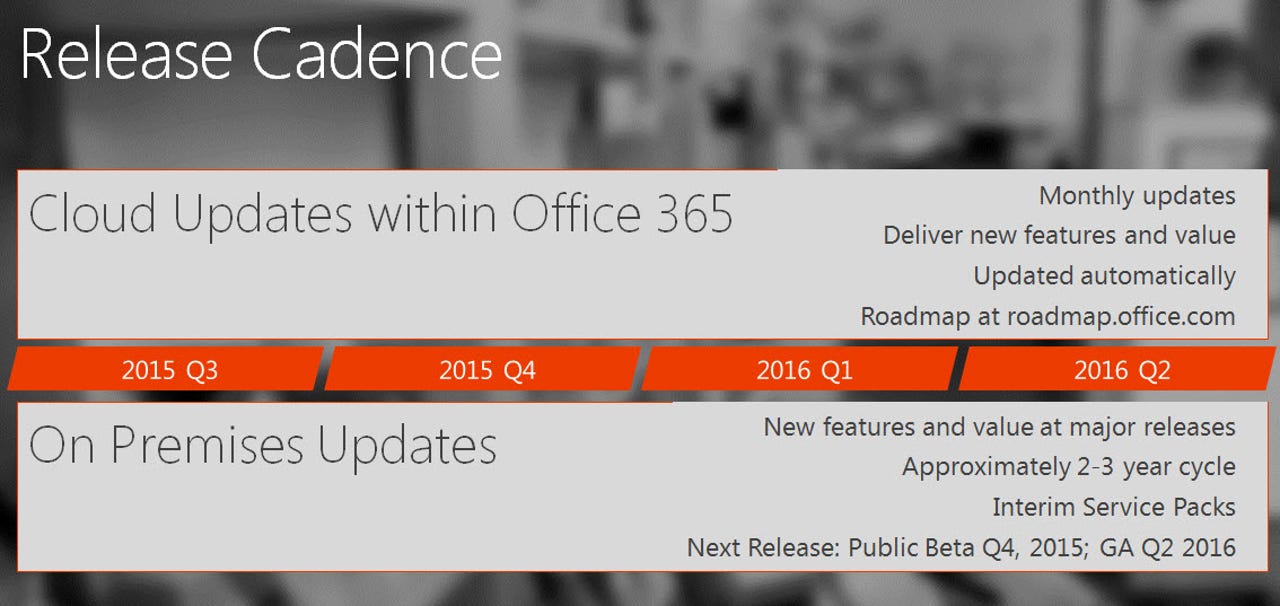Microsoft's SharePoint 2016: What's hybrid got to do with it?

SharePoint Server 2016 isn't due to customers until the second quarter of calendar 2016. But Microsoft used its Ignite conference last week to talk a bit about what users can expect as the product moves from preview to final over the next few months.

The "kernel" of both this online snapshot and SharePoint 2016 itself is SharePoint Server 2013. That means SharePoint 2016 will be focused, like its predecessor, on managing files, content management, sites and portals.
Though it will run on top of Windows Server 2016 R2 and/or Windows Server 2016, SharePoint 2016 will include support for what Microsoft calls "cloud-accelerated experiences," meaning new hybrid scenarios. Microsoft has been talking up the "hybridization" of SharePoint and other new servers for a while, but only after plowing through a bunch of the SharePoint sessions from Ignite (available for viewing by anyone from Microsoft's Channel 9 site), do I have a better feel for what this means.
Instead of trying to push all SharePoint users and all SharePoint workloads to the cloud, Microsoft is acknowledging there are some reasons (compliance among them) that not all data can or should be in SharePoint Online. That said, Microsoft wants to enable its SharePoint users to get at their data wherever it's stored.
Many new Office services, like the Office Graph and Delve Flipboard-for-Business-like application that runs on top of it, rely on the cloud to work. Office Graph, which Microsoft introduced last March, analyzes content, user interactions and activity streams and maps the relationships among these technolgies so that it can surface the most relevant content appropriate for each user. Office Graph is an extension of the Enterprise Graph concept in Yammer.
However, as Microsoft execs demonstrated at last week's show, there are ways to bring on-premises servers running SharePoint into the Office Graph picture.
Bill Baer, a Senior Technical Product Manager on SharePoint, demonstrated how users will be able to get a single set of search results that include data stored in SharePoint Online and SharePoint 2016 on-premises. Because Office Graph will "take signals" from SharePoint 2016, customers will be able to see the relationships between entities stored both in the cloud and on-premises.
And it's not just SharePoint 2016 that will enable this. Baer told attendees of one of his Ignite sessions that Microsoft will ship later this year an update that lets users leverage Delve and the Office Graph on SharePoint 2013, too. This doesn't mean Delve and the Office Graph run on SharePoint Server 2013 or SharePoint Server 2016. Instead, a spokesperson clarified, it means "we're enabling customers to leverage the Delve experience with on-premise data in SharePoint 2016 and SharePoint 2013."
What else is on tap for SharePoint 2016? Microsoft execs promised they'll be making operating, patching and updating SharePoint easier. (Mini server roles will help tame the patching and updating beast, officials said, by reducing overall datacenter footprint, as will new "zero downtime" online patching technology.)
PerformancePoint services -- which many of us last heard about back in 2009 when Microsoft dropped PerformancePoint Server -- are being ported back to SharePoint Server 2016. Project Server will be more tightly integrated, from a database standpoint, with SharePoint Server, though still remain a separate and separately priced product.
Microsoft officials said earlier this year and reiterated at Ignite that SharePoint Server 2016 will not be the last on-premises version of SharePoint. More versions are planned "for the foreseeable future," officials said.
And for those wondering, Microsoft execs say they also won't be dismantling SharePoint Online and replacing it with a bunch of individual, smaller-scoped features in Office 365. The official statement, from a spokesperson: "SharePoint Online will continue to play an important role as the platform underlying a number of Office 365 experiences, including next generation portals like Video, as well as Delve, OneDrive and Team Sites."